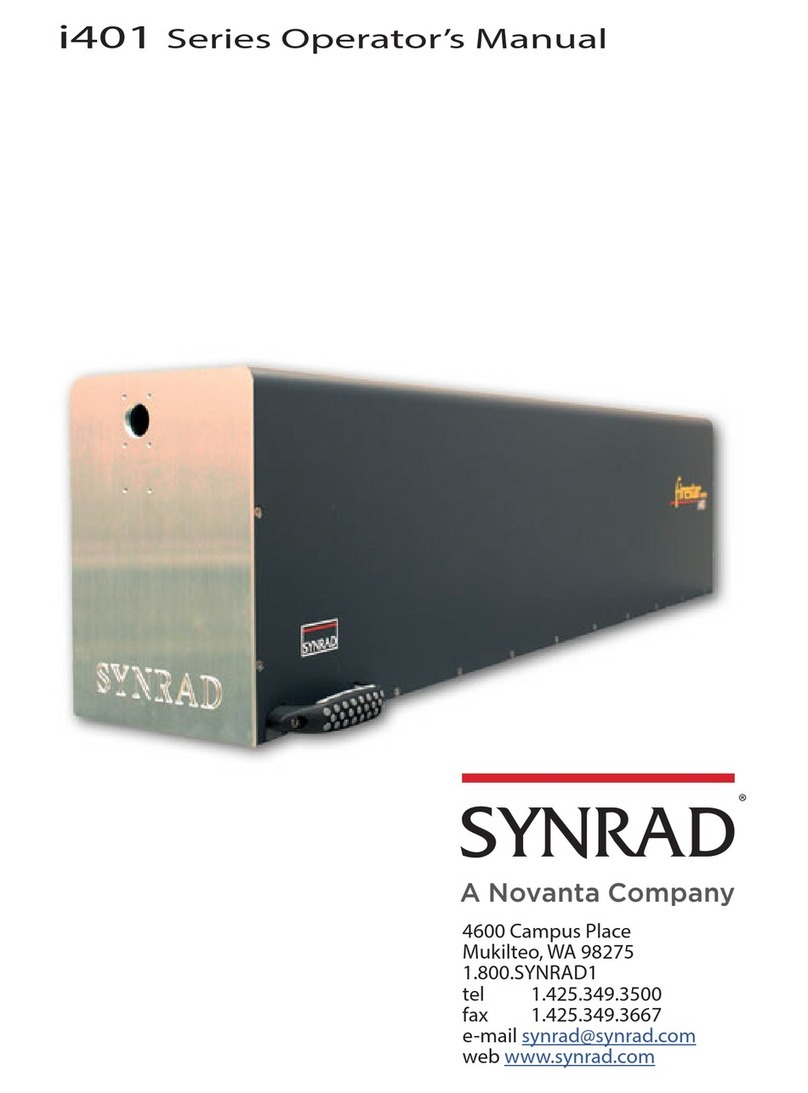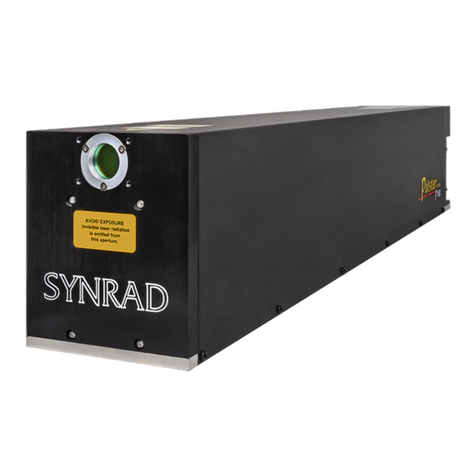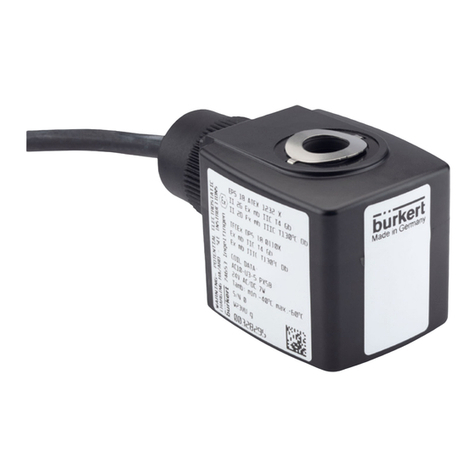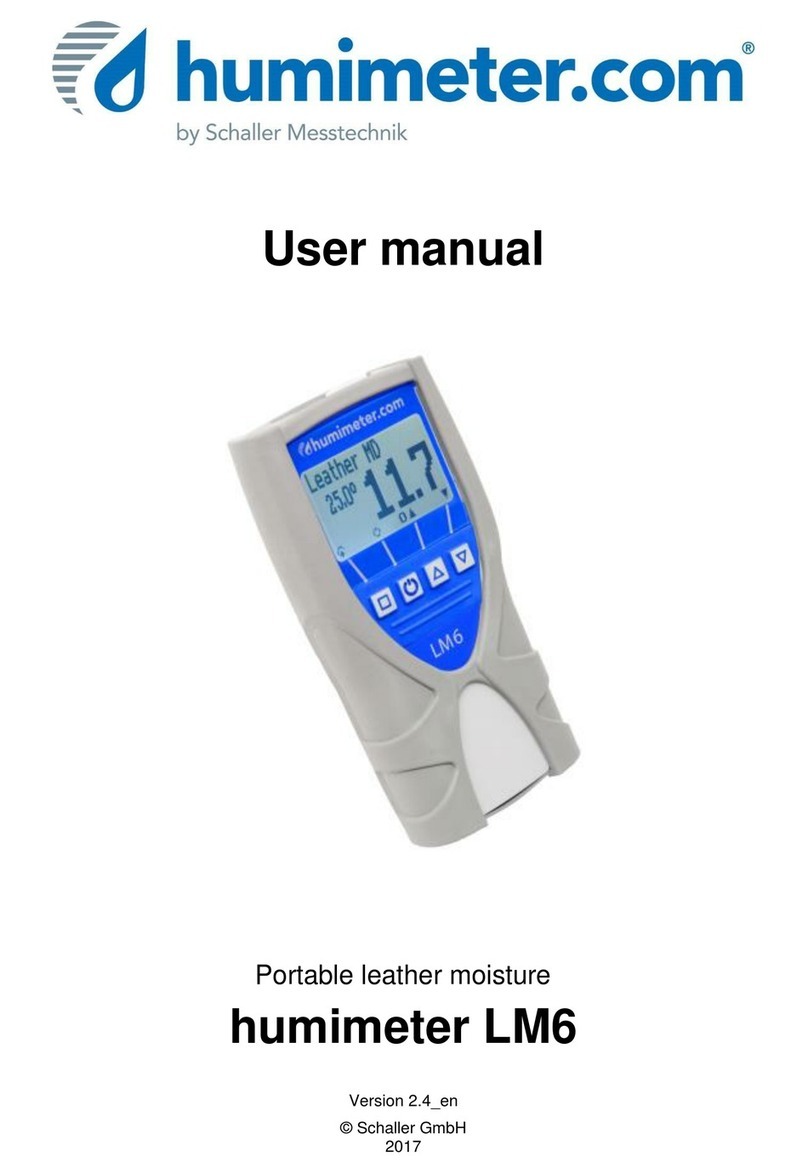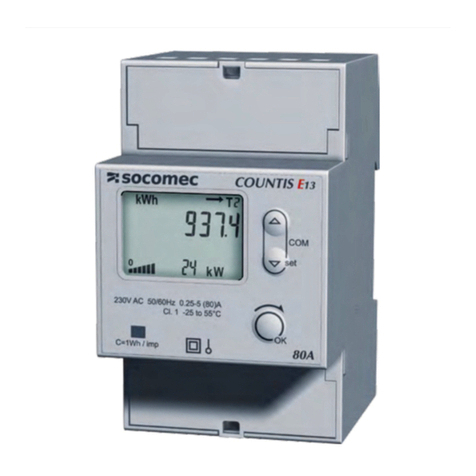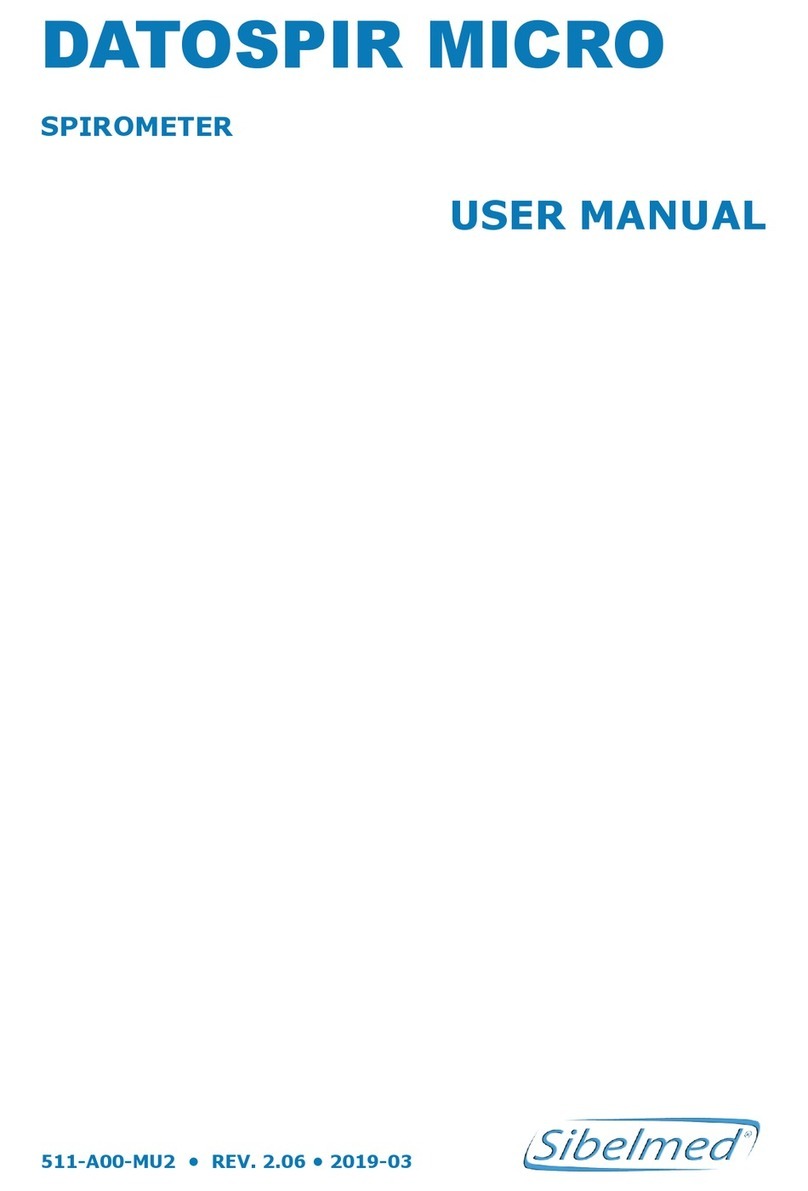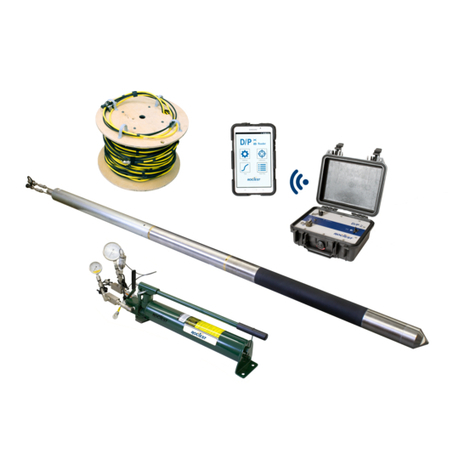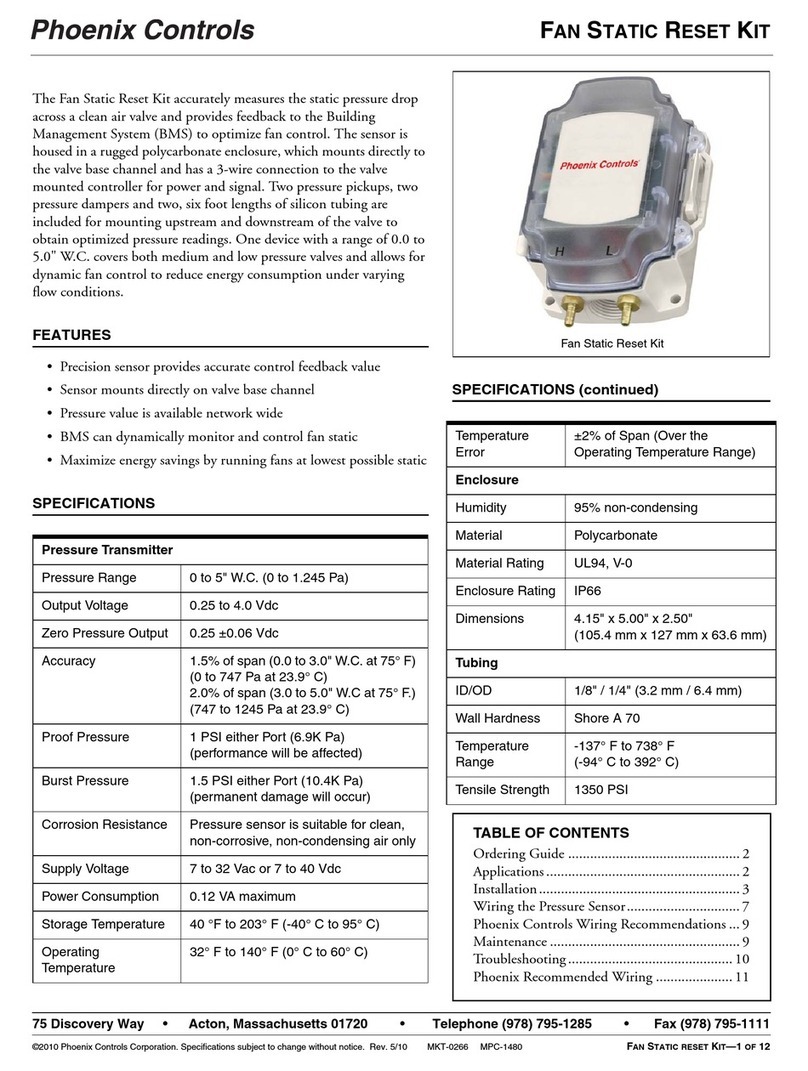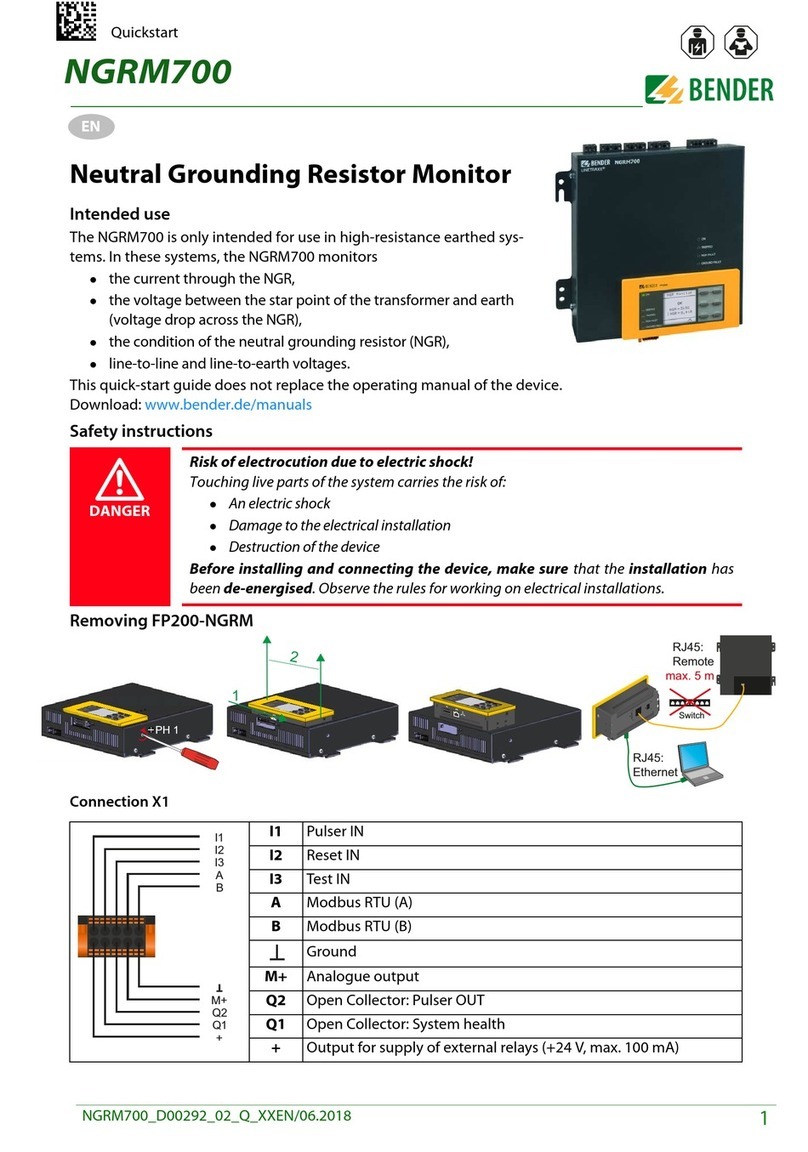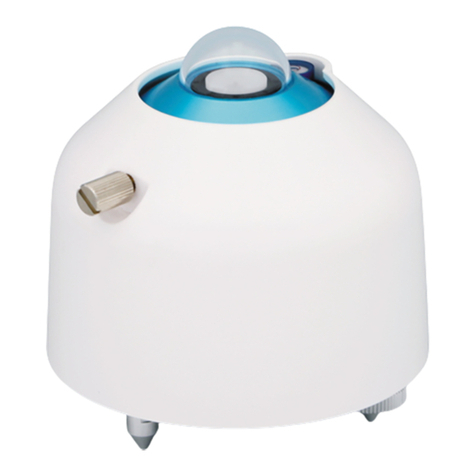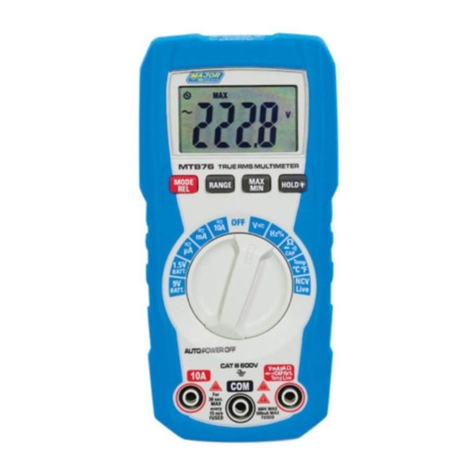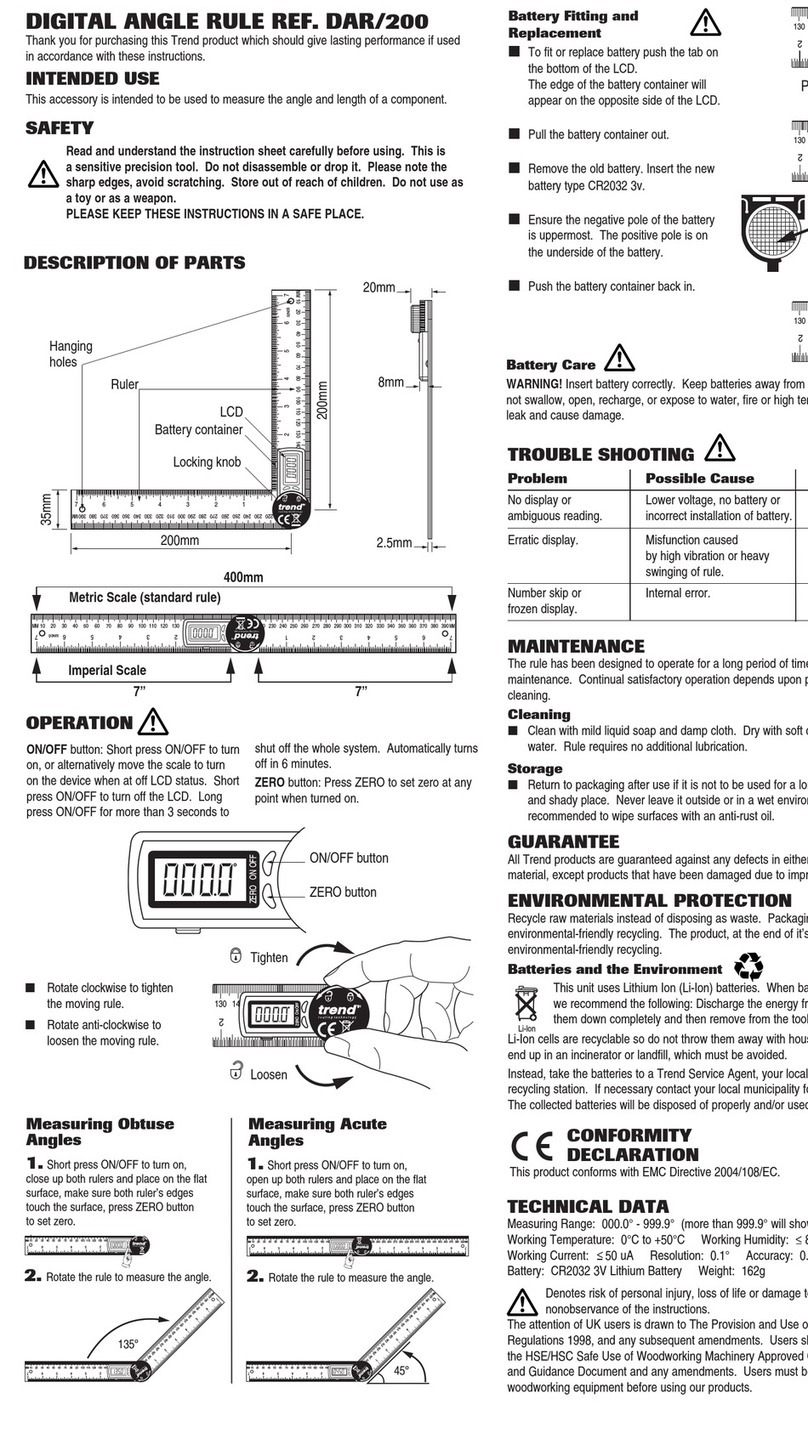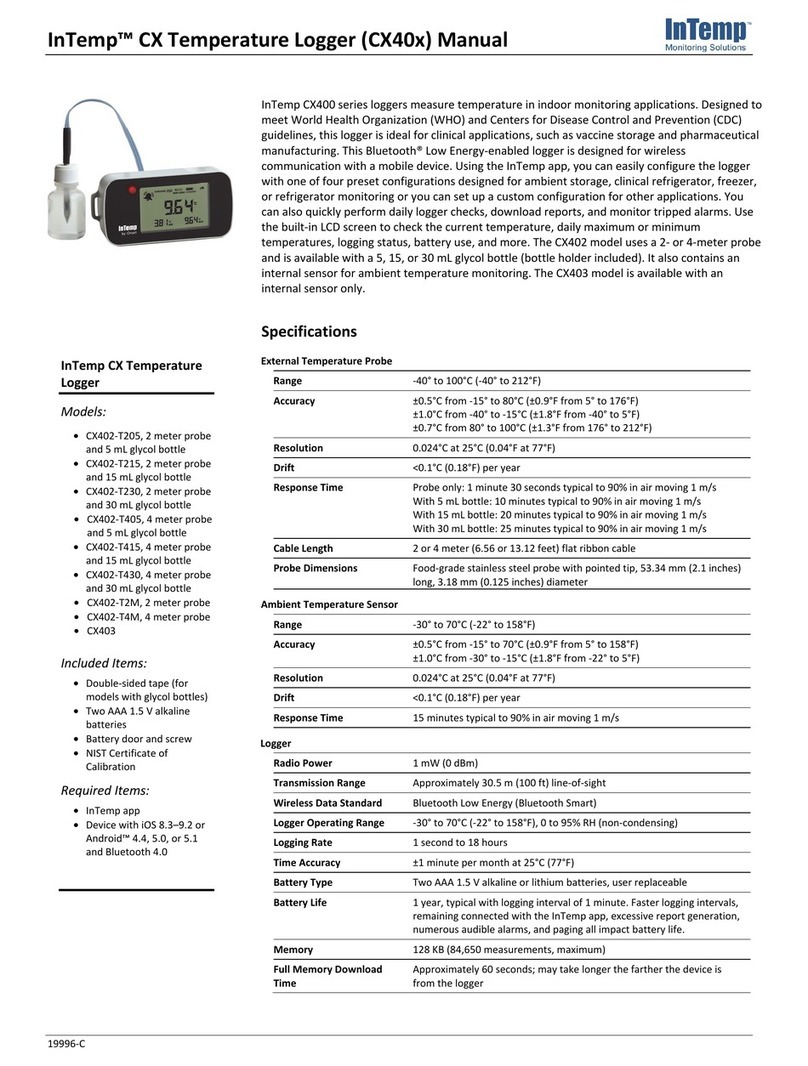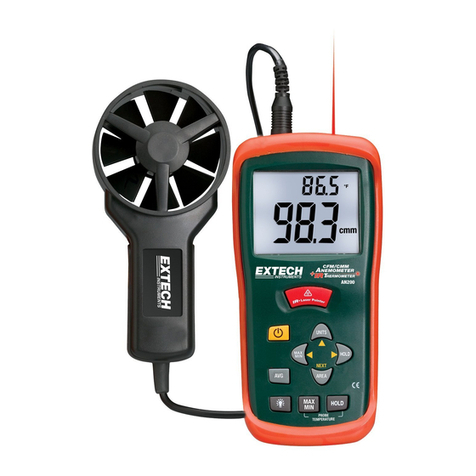Novanta vi30 User manual

ENGINEERED BY SYNRAD
vi30/vi40 Laser
User Manual

IMPORTANT INFORMATION PAGE |2
Table of Contents
Important Information ......................................................................................................................................................................5
Trademark & Copywrite ....................................................................................................................................................................7
Warranty Information .......................................................................................................................................................................7
Sales, Application & Support .............................................................................................................................................................8
Sales & Application ............................................................................................................................................................................8
Customer Service...............................................................................................................................................................................8
Technical Support ..............................................................................................................................................................................8
Reference Materials ..........................................................................................................................................................................9
Guidelines & Content ......................................................................................................................................................................10
Nomenclature..................................................................................................................................................................................12
Laser Safety......................................................................................................................................................................................13
Hazard Information .........................................................................................................................................................................13
Terms ...............................................................................................................................................................................................13
Other hazards ..................................................................................................................................................................................16
Disposal............................................................................................................................................................................................17
Additional laser safety information .................................................................................................................................................18
vi30 Laser label locations.................................................................................................................................................................19
vi40 Laser label locations.................................................................................................................................................................20
Agency Compliance .........................................................................................................................................................................21
Center for Devices and Radiological Health (CDRH) Requirements ................................................................................................21
Federal Communications Commission (FCC) Requirements ...........................................................................................................22
European Union (EU) requirements RoHS compliance ...................................................................................................................23
Operation.........................................................................................................................................................................................28
Controls and Indicators....................................................................................................................................................................28
Technical reference .........................................................................................................................................................................31
Technical overview ..........................................................................................................................................................................31
OEM vi30/40 design ........................................................................................................................................................................32
Optical setup....................................................................................................................................................................................33

IMPORTANT INFORMATION PAGE |3
Controlling laser power ...................................................................................................................................................................39
Control signals .................................................................................................................................................................................39
Operating Modes.............................................................................................................................................................................40
User I/O connection summary.........................................................................................................................................................45
DB-9 I/O connections.......................................................................................................................................................................45
Sample input circuit.........................................................................................................................................................................48
Sample output circuit ......................................................................................................................................................................51
Vi30/40 General Specifications........................................................................................................................................................52
General Specifications (Continued) .................................................................................................................................................53
O&M Drawings ................................................................................................................................................................................54
Maintenance & Troubleshooting.....................................................................................................................................................60
Cooling.............................................................................................................................................................................................61
Troubleshooting ..............................................................................................................................................................................64
Operational flowchart .....................................................................................................................................................................65
Status LEDs ......................................................................................................................................................................................66
Resetting faults................................................................................................................................................................................67
Beam delivery optics .......................................................................................................................................................................68
Index ..................................................................................................................................................................................................1
Table of Figures
Figure 1-1 vi30/40 ship kit contents. ...............................................................................................................................................11
Table 1-1 vi30/40 ship kit contents .................................................................................................................................................11
Figure 1-2 Anatomy of a model number. ........................................................................................................................................12
Figure 2-1 vi30 hazard label locations .............................................................................................................................................19
Figure 2-2 vi40 hazard label locations .............................................................................................................................................20
Table 2-1 Class 4 safety features. ....................................................................................................................................................24
Table 2-2 European Union Directives. .............................................................................................................................................25
Figure 2-3 vi30 Document ...............................................................................................................................................................26
Figure 2-4 vi40 Document ...............................................................................................................................................................27
Figure 3-1 OEM vi30/40 Front panel controls and indicators. ........................................................................................................29
Figure 3-2 OEM vi30/40 Rear panel controls and indicators...........................................................................................................30
Figure 4-1 vi30/40 beam ellipticity. .................................................................................................................................................33
Table 4-1 Assist gas purity specifications ........................................................................................................................................34

IMPORTANT INFORMATION PAGE |4
Figure 4-2 Recommended fan shroud example...............................................................................................................................35
Table 4-2 Dew Point Table °F temperatures....................................................................................................................................38
Table 4-3 Dew Point Table °C temperatures (continued)................................................................................................................39
Figure 4-3 Typical optical output pulse (50%) duty cycle at 3kHz. ..................................................................................................41
Figure 4-4 Typical optical output pulse (50%) duty cycle at 5kHz. ..................................................................................................41
Figure 4-5 PWM Command signal waveform .................................................................................................................................42
Table 4-4 PWM Command signal levels ..........................................................................................................................................43
Figure 4-6 DB-9 I/O connector pinouts............................................................................................................................................45
Table 4-5 DB-9 I/O pin descriptions.................................................................................................................................................46
Figure 4-7 Input equivalent schematic. ...........................................................................................................................................47
Table 4-6 DB-9 input circuit specifications. .....................................................................................................................................47
Figure 4-8 OEM vi30/40 powered Laser Enable circuit. ..................................................................................................................48
Figure 4-9 Customer powered laser enable circuit..........................................................................................................................48
Figure 4-10 PLC switched laser enable circuit. ................................................................................................................................49
Table 4-7 DB-9 output circuit specifications....................................................................................................................................50
Figure 4-11 Output equivalent schematic. ......................................................................................................................................50
Figure 4-12 Lase indicator output to PLC input ...............................................................................................................................51
Table 4-8 vi30/40 General specifications. .......................................................................................................................................52
Table 4-8 vi30/40 General specifications (continued).....................................................................................................................53
Figure 4-14 OEM vi40 standard package outline and mounting dimensions..................................................................................54
Figure 4-15 OEM vi30 package outline and mounting dimensions with optional customer-installed ‘Tall/Wide’ mounting feet. 55
Figure 4-16 OEM vi30 package outline and mounting dimensions .................................................................................................56
Figure 4-17 OEM vi30 Dual-cooled outline and mounting diagram ................................................................................................57
Figure 4-18 OEM vi40 Dual-cooled outline and mounting diagram. ...............................................................................................58
Figure 4-19 OEM vi30/40 packaging instructions............................................................................................................................59
Table 5-1 Required cleaning materials. ...........................................................................................................................................63
Figure 5-1 vi30/40 operational flowchart........................................................................................................................................65
Table 5-2 vi30/40 Input I/O status states. .......................................................................................................................................66

IMPORTANT INFORMATION PAGE |5
Important Information
For your protection, carefully read these instructions before installing and operating the scan
head.
Retain these instructions for future reference.
Novanta reserves the right to update this user manual at any time without prior notification.
If product ownership changes, this manual should accompany the product.
DANGER:Indicates a hazardous situation which, if not avoided, will result in serious injury or death.
Its use should be limited to the most extreme situations.
WARNING: Indicates a hazardous situation which, if not avoided, could result in serious injury or
death.
CAUTION: Indicates a hazardous situation which, if not avoided, could result in minor or
moderate injury.
Important: Indicates information considered important but not directly hazard related (e.g.,
security, hygiene, or equipment or property damage).
Safety Labels
DANGER:Laser radiation can cause severe retinal and corneal burns, burns on the skin, and may
pose a fire risk. To avoid injury and reduce risk of fire, please follow the control measures and
safety guidelines provided by the laser’s manufacturer, and those established by your Laser
Safety Officer (LSO), Radiation Safety Officer (RSO), or safety department of your business or
institution.
ESD Warning
MOVIA scan heads are electrostatic discharge-sensitive devices (ESD). The equipment should
remain sealed until the user is located at a proper static control station; improper handling could
cause damage to these electronics.
A proper static control station should include:
A soft grounded conductive tabletop or grounded conductive mat on the tabletop.
A grounded wrist strap with the appropriate (1 MΩ) series resistor connected to the tabletop mat
and ground.
An adequate earth ground connection, such as a water pipe or AC ground.
Conductive bags, trays, totes, racks, or other storage.
Properly grounded power tools.
Personnel handling ESD items should wear ESD protective garments and ground straps.
Important: Equipment returned to the factory must be shipped in anti-static packaging.

IMPORTANT INFORMATION PAGE |6
Important: Customers assume all responsibility for maintaining a laser-safe working environment.
Original equipment manufacturer (OEM) customers assume all responsibility for CDRH (Center
for Devices and Radiological Health) certification.
Customer Support
Before contacting Novanta for assistance, review appropriate sections in the manual that may
answer your questions.
After consulting this manual, please contact one of our worldwide offices between 9 AM and 5 PM
local time.
Americas, Asia Pacific
Novanta Headquarters, Bedford, USA
Phone: +1-781-266-5700
Email: photonics@novanta.com
Europe, Middle East, Africa
Novanta Europe GmbH, Wackersdorf, Germany
Phone: +49 9431 7984-0
Email: photonics@novanta.com
Milan, Italy
Phone: +39-039-793-710
Email: photonics@novanta.com
China
Novanta Sales & Service Office, Shenzhen, China
Phone: +86-755-8280-5395
Email: photonics.china@novanta.com
Novanta Sales & Service Office, Suzhou, China
Phone: +86-512-6283-7080
Email: photonics.china@novanta.com
Japan
Novanta Service & Sales Office, Tokyo, Japan
Phone: +81-3-5753-2460
Email: photonics.japa[email protected]

TRADEMARK & COPYWRITE PAGE |7
Trademark & Copywrite
NOVANTA© and vi30/40 lasers are registered trademarks of NOVANTA.
All other trademarks or registered trademarks are the property of their respective owners.
2019 by NOVANTA.
All rights reserved.
Warranty Information
This is to certify that vi30/40 lasers are guaranteed by NOVANTA to be free of all defects in materials
and workmanship for a period of one year from the date of purchase. This warranty does not apply to
any defect caused by negligence, misuse (including environmental factors), accident, alteration, or im-
proper maintenance. We request that you examine each shipment within 10 days of receipt and inform
NOVANTA of any shortage or damage. If no discrepancies are reported, NOVANTA shall assume the
shipment was delivered complete and defect-free.
If, within one year from the date of purchase, any part of the laser should fail to operate, contact the
NOVANTA Customer Service department at 1.800.NOVANTA1 (outside the U.S. call 1.425.349.3500) and
report the problem. When calling for support, please be prepared to provide the date of purchase, model
number and serial number of the unit, and a brief description of the problem. When returning a unit for
service, a Return Authorization (RA) number is required; this number must be clearly marked on the
outside of the shipping container for the unit to be properly processed. If replacement parts are sent to
you, then you are required to send the failed parts back to NOVANTA for evaluation unless otherwise
instructed.
If your vi30/40 laser fails within the first 45 days after purchase, NOVANTA will pay all shipping charges
to and from NOVANTA when shipped as specified by NOVANTA Customer Service. After the first 45
days, NOVANTA will continue to pay for the costs of shipping the repaired unit or replacement parts
back to the customer from NOVANTA. The customer, however, will be responsible for shipping charges
incurred when sending the failed unit or parts back to NOVANTA or a NOVANTA Authorized Distributor.
To maintain your product warranty and to ensure the safe and efficient operation of your vi30/40 laser,
only authorized NOVANTA replacement parts can be used. This warranty is void if any parts other than
those provided by NOVANTA are used.
NOVANTA and NOVANTA Authorized Distributors have the sole authority to make warranty statements
regarding NOVANTA products. NOVANTA and its Authorized Distributors neither assumes nor
authorizes any representative or other person to assume for us any other warranties in connection with
the sale, service, or shipment of our products. NOVANTA reserves the right to make changes and
improvements in the design of our products at any time without incurring any obligation to make
equivalent changes in products previously manufactured or shipped. Buyer agrees to hold NOVANTA
harmless from all damages, costs, and expenses relating to any claim arising from the design,
manufacture, or use of the product, or arising from a claim that such product furnished Buyer by
NOVANTA, or the use thereof, infringes upon any Patent, foreign or domestic.

SALES, APPLICATION & SUPPORT PAGE |8
Sales, Application & Support
Novanta Sales and Support
NOVANTA® worldwide headquarters are located north of Seattle in Mukilteo, Washington. U.S.A. Our
mailing address is:
NOVANTA 4600 Campus Place Mukilteo, WA 98275 U.S.A.
Phone us at:
1.800.NOVANTA1 (1.800.796.7231)
Outside the U.S.:
+1.425.349.3500
Fax:
+1.425.349.3667
E-mail:
Novanta@Novanta.com
Sales & Application
NOVANTA Regional Sales Managers work with customers to identify and develop the best CO2 laser
solution for a given application. Because they are familiar with you and your laser application, use them
as a first point of contact when questions arise. Regional Sales Managers also serve as the liaison
between you and our Applications Lab in processing material samples per your specifications. To speak
to the Regional Sales Manager in your area, call NOVANTA at 1.800. NOVANTA1.
Customer Service
For assistance with order or delivery status, service status, or to obtain a Return Authorization (RA)
number, contact NOVANTA at 1. 800.NOVANTA1 and ask to speak to a Customer Service representative,
or you can email us by sending a message to customercare@Novanta.com.
Technical Support
NOVANTA Regional Sales Managers can answer many technical questions regarding the installation, use,
troubleshooting, and maintenance of our products. In some cases, they may transfer your call to a Laser,
Marking Head, or Software Support Specialist. You may also e-mail questions to the Technical Support
Group by sending your message to Novanta tech support Novanta.com.

REFERENCE MATERIALS PAGE |9
Reference Materials
Your Regional Sales Manager can provide reference materials including Outline & Mounting drawings,
Operator’s Manuals, Technical Bulletins, and Application Newsletters. Most of these materials are also
available directly from the NOVANTA web site at http://www.Novanta.com.
EU Headquarters
For assistance in Europe, contact NOVANTA® European subsidiary, NOVANTA Europe, at:
©Novanta Distribution (USD) GmbH
Parkring 57-59
85748 Garching bei München,
Germany
Phone: +49 89 31707-0
web: www.Novanta.com
E-mail: EMEA-service@novanta.com
For assistance in China, contact NOVANTA® at:
Novanta China Sales and Service Center
2401-J, Bak Building, Hi-tech Park, Nanshan District Guangdong, PRC 518057
Phone: +86 (755) 8280 5395
Fax: +86 (755) 8672 1125
E-mail: sales-china@Novanta.com
web: www.Novanta.com

GUIDELINES & CONTENT PAGE |10
Guidelines & Content
Refer to the drawings, located in the technical reference chapter, when installing and operating your
vi30/40 laser. Also reference the vi30/40 quick start guide located on our website.
•Unpacking/Packing
Storage/Shipping
Mounting/Connecting/Cooling
•vi/40 nomenclature/ features
NOVANTA recommends saving all of the laser’s original packaging. It’s unique design assists in
preventing damage to your laser during storage, relocation and/or shipping.
Reference our Quick Start Guide Series at Novanta.com. Additional information can also be found in the
Technical Reference section within this manual.
Contents description
Each item below is also listed in tables that follow:
OEM vi30/40 Laser – for cutting, welding, drilling, and marking a wide variety of products and materials.
Customer Communication Flier vi30/40- Instead of the laser manual CD, please follow the instructions
for our latest laser manual(s) located here: http://www.synrad.com/Manuals/manuals_laser.htm.
Mounting bolts – Three each 1/4-20 x 5/8 UNC caps crews are provided for fastening the vi30/40 laser
to your mounting surface.
Spare Fuse – Two fast-blow vi30 12 A Cooper Bussmann BK/ABC-12-R or RoHS equivalent (novanta P/N
521-00058-01), fast-blow fuses and two fast-blow vi40 20 A Cooper Bussmann ABC-20-R or equivalent
20 A (novanta P/N521-00005-01), fast-blow fuses incorporated into the positive DC power cable
protects the laser’s internal circuitry. See Troubleshooting in the Maintenance and Troubleshooting
chapter for additional information.
Final Test Report (not shown) – Contains data collected during the laser’s final pre-shipment test.

GUIDELINES & CONTENT PAGE |11
Figure 1-1 vi30/40 ship kit contents.
Table 1-1 vi30/40 ship kit contents
Only with fan and water-cooled models
Shipping Box Contents Qty
vi30/40 Laser 1
Customer Flier 1
Cooling kit 1
DC power cable set (not shown) 1
Mounting Bolts 3
Spare Fuse 4
Final Test Report (not shown 1

NOMENCLATURE PAGE |12
Nomenclature
•Model numbers
•vi30/40 laser versions
The last three characters in the Firestar model number serve to designate the functional category,
cooling method, and model version. The functional category is indicated by either a “K” for Keyswitch or
“S” Standard (OEM) for OEM models. The next letter indicates the cooling method: “W” for water-cooled
units, “F” for fan-cooled units, and “A” for air-cooled lasers (where the customer must provide the proper
cooling via fans or blowers). The last letter in the model number indicates the current model version
beginning with “B.” For example, the model number FSVi30SAB designates the vi30 laser as a standard
OEM, air-cooled version B.
Figure 1-2 Anatomy of a model number.

LASER SAFETY PAGE |13
Laser Safety
Read the entire safety section. This will ensure you are familiar with the hazards and warnings prior to
starting.
•Hazard Information – includes equipment label terms and hazards, please familiarize yourself
with all definitions and their significance.
•General & Other Hazards – provides important information about the hazards and unsafe
practices that could result in death, severe injury, or product damage.
•Disposal – information on your vi30/40 laser parts and/or components as they pertain to
disposal.
•Additional Safety Information – describes how to find additional information about your laser.
•Compliance – explains in the subsections therein applicable and appropriate regulation
information.
Hazard Information
Hazard information includes terms, symbols, and instructions used in this manual or on the equipment to
alert both operating and service personnel to the recommended precautions in the care, use, and
handling of Class 4 laser equipment.
Terms
Certain terms are used throughout this manual or on the equipment labels. Please familiarize yourself
with their definitions and significance.
Warning: Serious Personal Injury
Safety Data sheets (SDS) for materials processed should be evaluated and the adequacy of
provisions for fume extraction, filtering and venting should be carefully considered.
This Class 4 CO2 laser product emits invisible infrared laser radiation in the 9.3–10.6 μm wavelength
band.
Because direct or diffuse laser radiation can inflict severe corneal injuries, always wear eye protection
when in the same area as an exposed laser beam. Do not allow the laser beam to contact a person!
This product emits an invisible laser beam that is capable of seriously burning human tissue. Always
be aware of the beam’s path and always use a beam block while testing.

TERMS PAGE |14
•Warning: Potential & Imminent hazards which, if not avoided, could result in death or serious
injury. Alerts operator of serious dangers, hazardous radiation, hazardous voltages, vapor hazard,
& reflective dangers.
•Danger: Hazards which, if not avoided, could result in minor or moderate injury. Alerts operator
of lifting dangers.
•Caution: Potential hazards or unsafe practices which, if not avoided, may result in product
damage. Alerts operator of equipment dangers.
•Important note: Content specific information and/or recommendations.
Warning: Serious Personal Injury
For laser systems being used or sold within the U.S.A., customers should refer to and follow the laser
safety precautions described American National Standards Institute (ANSI) document Z136.1-2014,
Safe Use of Lasers.
For laser systems being used or sold outside the U.S.A., customers should refer to and follow the laser
safety precautions described in European Normative and International Electrotechnical Commission
documents IEC/ TR 60825-14:2014, Safety of Laser Products – §14: A User’s Guide.

TERMS PAGE |15
Following are descriptions of general hazards and unsafe practices that could result in death, severe
injury, or product damage. Specific warnings and cautions not appearing in this section are found
throughout the manual.
Light hazards
Lasers should be installed and operated in manufacturing or laboratory facilities by trained personnel
only. Due to the considerable risks and hazards associated with the installation and operational use of
any equipment incorporating a laser, the operator must follow product warning labels and instructions to
the user regarding laser safety. To prevent exposure to direct or scattered laser radiation, follow all
safety precautions specified throughout this manual and exercise safe operating practices per ANSI
Z136.1-2014, Safe Use of Lasers always when actively lasing.
Due to the specific properties of laser light, a unique set of safety hazards that differ from other light
sources must be considered. Just like light, lasers can be reflected, refracted, diffracted, or scattered.
A CO2 laser is an intense energy source and will ignite most materials under the proper conditions. Never
operate the laser in the presence of flammable or explosive materials, gases, liquids, or vapors.
Safe operation of the laser requires the use of an external beam block to safely block the beam from
traveling beyond the desired work area. Do not place your body or any combustible object in the path of
the laser beam. Use a water-cooled beam dump or power meter, or similar non-scattering,
Warning: Serious Personal Injury
Enclose the beam path whenever possible. Exposure to direct or diffuse CO2 laser radiation can
seriously burn human or animal tissue, which may cause permanent damage.
This product is not intended for use in explosive, or potentially explosive, atmospheres!
Materials processing with a laser can generate air contaminants such as vapors, fumes, and/or
particles that may be noxious, toxic, or even fatal.
Safety Data Sheets (SDS) for materials being processed should be thoroughly evaluated and the
adequacy of provisions for fume extraction, filtering, and venting should be carefully considered.
Review the following references for further information on exposure criteria:
ANSI Z136.1-2014, Safe Use of Lasers, § 7.3.
U.S. Government’s Code of Federal Regulations: 29 CFR §1910, §§ Z.
Threshold Limit Values (TLV’s) published by the American Conference of Governmental Industrial
Hygienists (ACGIH).
It may be necessary to consult with local governmental agencies regarding restrictions on the venting
of processing vapors.
The use of aerosol dusters containing difluoroethane causes “blooming,” a condition that significantly
expands and scatters the laser beam. This beam expansion can affect mode quality and/or cause
laser energy to extend beyond the confines of optical elements in the system, damaging acrylic
safety shielding. Do not use air dusters containing difluoroethane in any area adjacent to CO2 laser
systems because difluoroethane persists for long time periods over wide areas.

OTHER HAZARDS PAGE |16
noncombustible material as the beam block. Never use organic material or metals as the beam blocker;
organic materials, in general, are apt to combust or melt and metals act as specular reflectors which may
create a serious hazard outside the immediate work area.
Other hazards
The following hazards are typical for this product family when incorporated for intended use:
(A) risk of injury when lifting or moving the unit; (B) risk of exposure to hazardous laser energy through
unauthorized removal of access panels, doors, or protective barriers; (C) risk of exposure to hazardous
laser energy and injury due to failure of personnel to use proper eye protection and/or failure to adhere
to applicable laser safety procedures; (D) risk of exposure to hazardous or lethal voltages through
unauthorized removal of covers, doors, or access panels; (E) generation of hazardous air contaminants
that may be noxious, toxic, or even fatal.
Warning: Serious Personal Injury
Always wear safety glasses or protective goggles with side shields to reduce the risk of damage
to the eyes when operating the laser.
The use of controls or adjustments or performance of procedures other than those specified herein
may result in hazardous radiation exposure
Never use organic materials or metals as a beam blocker. There are very few exceptions, eg. Black
anodized metal such as aluminum because this is non reflective surface.

THORIUM SAFETY PAGE |17
Thorium Safety
•This laser system incorporates a II-VI Infrared optical component.
•This optical component contains a small amount of thorium fluoride, a type of source material (less
than 10% by weight).
•It is exempt from USNRC licensing regulations as an “unimportant quantity of source material” per
10 CFR 40.13(c) (7).
•Shaping, grinding, polishing, or alteration of the optical component is prohibited.
•Use of this optical component in contact lenses, spectacles, or in eyepieces in binoculars or other
similar optical instruments is prohibited.
Cleaning optical components is permitted so long as care is taken not to damage the coated surface of
the component as sold. This II-VI Infrared requirement only applies to lenses and optics manufactured and
distributed by II-VI Infrared. Distributing components or devices that contain lenses and optics
manufactured by other companies as if it were manufactured by II-VI Infrared is not in compliance with
USNRC distribution requirements.
U.S. distribution of components or devices that contain lenses and optics manufactured by other
companies which contain uranium and/or thorium requires a USNRC distribution license. Only II-VI Infrared
manufactured lenses and optics which contain thorium are covered by the II-VI Infrared distribution
license.
10 CFR 40.13(c) (7) Unimportant quantities of source material.
(7) Thorium or uranium contained in or on finished optical lenses and mirrors, provided that each lens or
mirror does not contain more than 10 percent by weight thorium or uranium or, for lenses manufactured
before August 27, 2013, 30 percent by weight of thorium; and that the exemption contained in this
paragraph does not authorize either:
(i) The shaping, grinding, or polishing of such lens or mirror or manufacturing processes other than the
assembly of such lens or mirror into optical systems and devices without any alteration of the lens or
mirror; or
(ii) The receipt, possession, use, or transfer of uranium or thorium contained in contact lenses, or in
spectacles, or in eyepieces in binoculars or other optical instruments.
Disposal
This product contains components that are considered hazardous industrial waste. If a situation occurs
where the laser is rendered non-functional and cannot be repaired, it may be returned to NOVANTA®
who, for a fee, will ensure adequate disassembly, recycling and/or disposal of the product.

ADDITIONAL LASER SAFETY INFORMATION PAGE |18
Additional laser safety information
The NOVANTA web site https://www.Novanta.com/resources/general_information/lasersafetyresources
contain an online laser safety handbook that provides information on (1) Laser Safety Standards for
OEM’s/System Integrators, (2) Laser Safety Standards for End Users, (3) References and Sources, and
(4) Assistance with Requirements.
In addition, the Occupational Safety and Health Administration (OSHA) provides an online Technical
Manual located at http://www.osha.gov/dts/osta/otm/otm_iii/otm_iii_6.html Section III, Chapter 6 and
Appendix III are useful resources for laser safety information.
Another excellent laser safety resource is the Laser Institute of America (LIA). Their comprehensive web
site is located at http://www.lia.org.

VI30 LASER LABEL LOCATIONS PAGE |19
vi30 Laser label locations
Figure 2-1 vi30 hazard label locations

VI40 LASER LABEL LOCATIONS PAGE |20
vi40 Laser label locations
Figure 2-2 vi40 hazard label locations
This manual suits for next models
1
Table of contents
Other Novanta Measuring Instrument manuals
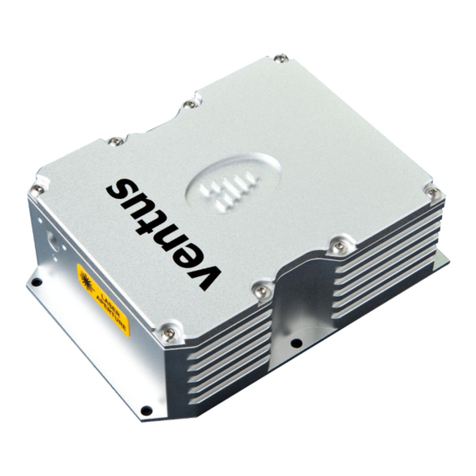
Novanta
Novanta ventus with mpc6000 User manual

Novanta
Novanta ATI Axia80 User manual

Novanta
Novanta i401 User manual

Novanta
Novanta p400 OEM Series User manual

Novanta
Novanta f201 User manual

Novanta
Novanta gem with smd24 User manual

Novanta
Novanta v30 User manual
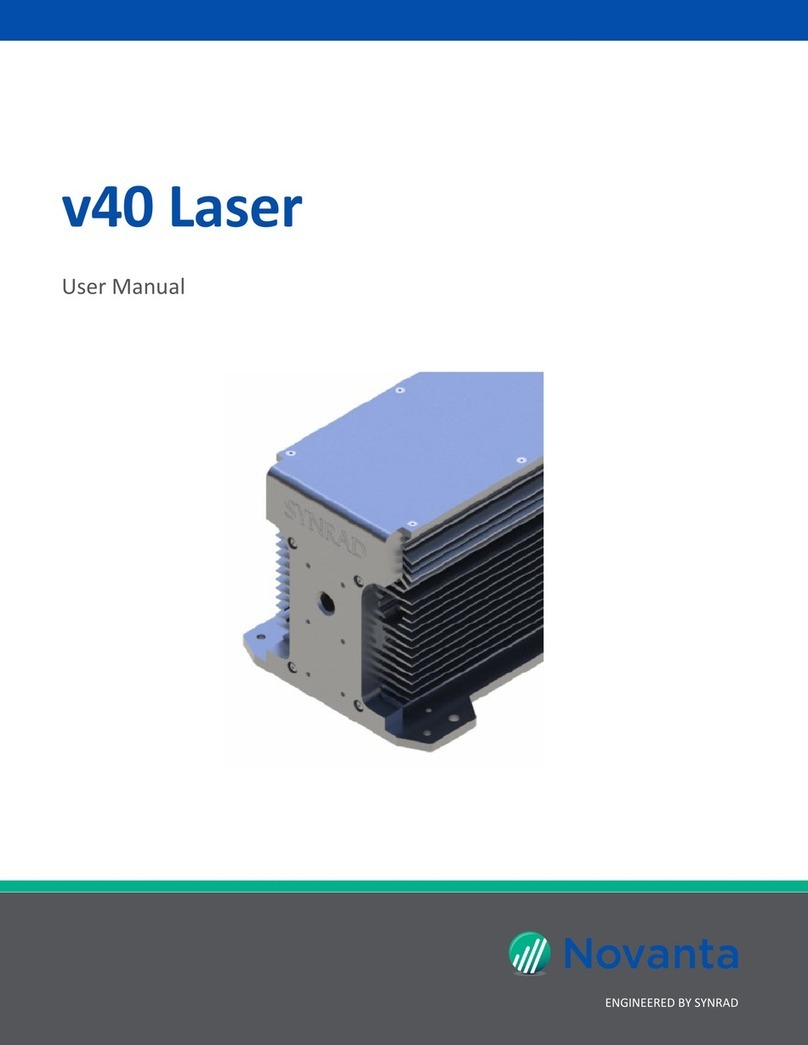
Novanta
Novanta v40 User manual

Novanta
Novanta JADAK FM-8 User manual

Novanta
Novanta Synrad ti Series User manual


